
There are certainly fewer hours spent working during November in the vegetable garden and a much more relaxed approach of getting things done as the weather permits. Even so, there is still some work to do, the main one being winter digging and adding organic matter to the soil, both of which help my fitness levels, saving me the cost of a gym membership!
There aren’t many things to plant in the garden, but there is work to do in the fruit garden and as soon as the leaves have fallen and trees are dormant, bare rooted fruit trees can also be bought and planted out before the ground becomes too hard to dig. Established fruit trees can be moved if they aren’t too big to dig up as well.
We are still harvesting a little produce during November; so thankfully, there is still a good supply of veggies for our table but soon they will be in short supply.
There are still a few things that can still be planted in November:
If you didn’t plant garlic last month then it’s not too late. Ideally it needs at least a few weeks to sprout some green leaves before getting the cold frosts over winter. Come the end of next summer, it should have grown into some fairly serious sized bulbs. If the ground is waterlogged, it will rot, so it is better to set cloves in coir pots or even 3” pots to get them started before the frosts.
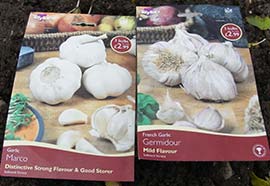
I couldn’t be without the taste of fresh homegrown peas! Round-seeded peas such as Douce Provence, Feltham First or Meteor are hardy enough to be planted during November in a sunny, sheltered spot in fertile soil and overwintered ready for a head start in spring. Use cloches to protect them during freezing weather.
Broad beans have a poor reputation; yet young broad beans are much tastier than the fully-grown beans, which tend to be leathery. Sowing twice a year will provide you with a good supply. Sow now for a crop in June and again in June for a September crop. Use a cloche to protect the young plants until they outgrow it. Some varieties such as Aquadulce or Super Aquadulce will need a sheltered site that isn’t open to strong winds.
November is an ideal time for planting rhubarb crowns. You can also divide large crowns to improve them and increase your stock. Dig up large crowns and split into quarters using a sharp, clean spade. For very large crowns, the centre may have rotted and you may need to remove this.
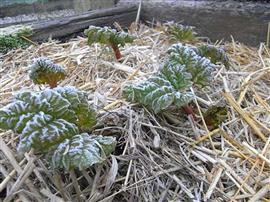
In October’s ‘In the greenhouse or polytunnel’, I said how important ventilation was over the winter months. This month, if you have decided to heat your greenhouse, you will need to think about starting now as the night-time temperatures fall. If you want to provide some heat but haven’t chosen how to do this yet then read September’s ‘In the greenhouse or polytunnel’, which discusses both kerosene, paraffin and electric for heating.
Electric heaters are the best but also the most expensive. Kerosene or paraffin heaters are cheaper to run but ventilation becomes much more important and you will soon find the smell of the fuel hangs around. The wick should always be kept trimmed. A flame with a yellow tip indicates incorrect combustion and your heater will then be producing a toxic combination of gasses such as benzene and carbon monoxide.
I have tried keeping plants heated and unheated over the winter months and I only tend to use heat now when I really have to which is usually in the early spring when I have the greenhouses full of young plants waiting for the weather to warm up.
Carrots
Now the greenhouse is clear, why not sow a short-rooted, fast growing variety of carrot such as Early Nantes. These should be ready to harvest in the spring before other spring-sown carrots are ready.
Here are my jobs for November in our garden:
I usually use bonfire night on November 5th as a good reason to burn off our hedge cuttings that were cut during September. By now, they have dried out a little and any smoke that does blow across a neighbouring garden is less likely to offend around Guy Fawkes and during the evening. Only light a fire if you have the space to do so and can do it safely.
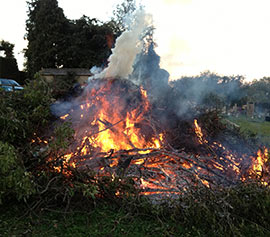
This can be done once the leaves have fallen as the sap will no longer be rising. It is also worth checking around the edge of your plot for tree roots that are coming into the planting area.
Old rhubarb leaves should be removed now. A thick layer of well rotted manure can be added to the surface of the soil.
Chives are useful for putting off many pests in the garden so in organic gardens are often sown between vegetable beds. They can be divided and propagated now if you want to increase their numbers.
Tall Brassicas get blown over in strong winter winds, spoiling the crop. Stake them and net brassicas if pigeons are a problem on your plot.
Leaves can be raked up, wet if necessary and compacted down by treading on them in a compost bin to make leaf mould compost. This is created with the help of fungi which decomposes the leaves (compost heaps on the other hand rot down mainly using bacteria). The leaves turn into a beautifully rich, crumbly compost in a year or so. Not all leaves are suitable for composting this quickly though, evergreens being far slower so are best avoided.
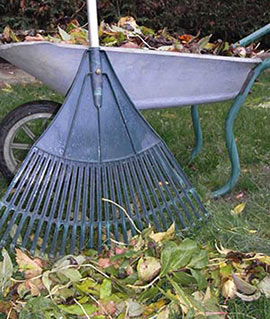
As beds become vacant, I dig in organic matter according to my plot rotation plan. Keep in mind that digging waterlogged soil can ruin its structure and it will become compacted when you stand on it. Only dig when the soil is dry enough / doesn’t stick to your boots!
If time is short and you don’t fancy digging in organic matter or the weather is wet, then a mulch of compost not only protects the surface of the soil from erosion by rain but worms will gradually draw it down into the soil, improving its texture without you having to dig it in.
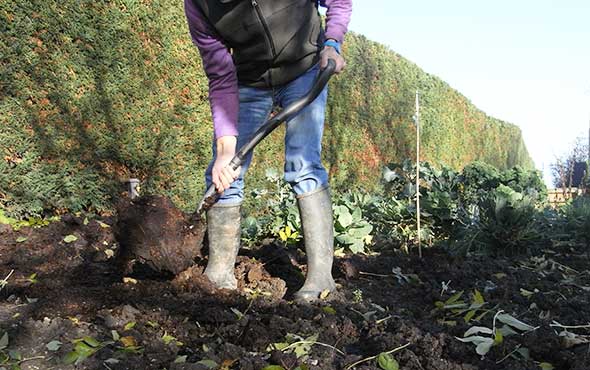
With less distraction from the vegetable garden, November is a great time for tidying up in the fruit garden and planting new bare-root fruit trees now that the sap is no longer rising.
Once the sap stops rising, trees can be moved. Trim damaged roots or branches with sharp secateurs and remove any diseased branches. Use generous amounts of compost mixed with soil when planting. Stake once in the ground to ensure they cannot move around in the winter winds, disturbing their roots. Water during dry periods until the following autumn.
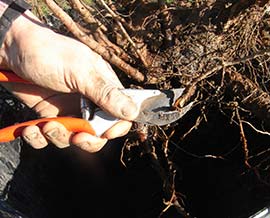
Bushes grow better if light and air are allowed to circulate amongst the branches so remove dead or diseased branches and any that are touching the ground and then remove branches that are crowding the centre, leaving around five main branches.
Taking hardwood cuttings isn’t difficult. Recent research suggests blackcurrants are one of the best ‘superfoods’. They contain more antioxidants that fight disease than any other fruit so are well worth growing in your garden or allotment.
Propagating Blackcurrant Bushes – Step by Step
[photos]
1
Choose a vigorous, healthy bush that is free of disease. Cut 30cm long brown (not green) stems from the bush just below a bud, using sharp, clean secateurs.
2
Make a small shallow trench and in it, add some horticultural grit or sharp sand for drainage.
3
Remove the lower leaves and plant the stems using the soil removed from the trench with 4 buds (about 20cm) below the soil and at least 2 buds above.
4
Water well. They should begin to grow the following spring. Once established, transplant to their final position into rich soil with plenty of well rotted manure.
Grapes can be grown inside a greenhouse or polytunnel or outdoors in a sheltered position, but wherever you grow them, you will find they like to spread out. If left until spring, grapevines will bleed sap so now is the best time to prune them.
Winter moths are often a problem for apples, pears, plums and cherries amongst others. Adults come out of the ground from autumn into winter and the female crawls up the trees to lay eggs. Once hatched, the caterpillars feed on flowers and leaves. Grease bands around the trunk will stop them in their tracks.
Figs can produce up to three crops per year in warmer climates. In the UK, fruit that was produced in the spring or early summer should be removed now, as it will not have a chance to ripen. Pea sized fruit that is produced in autumn is the fruit that will develop into a crop next year. Cover trees with fleece now to protect them from frost.
Any late apples that were left on the trees should be removed now before the strong winter winds blow them off the tree onto the ground.
Autumn fruiting Raspberries need pruning now that they have finished. Cut out canes that fruited this year, leaving this year’s new growth ready to bare fruit next year.
Although the harvest has tailed off, there are still a few things that can be harvested now.
Early varieties of Brussels Sprouts that were sown during the spring can be harvested towards the end of this month.
Winter Radishes that were sown in July and August can be harvested now but unlike the normal summer varieties, they will last a long time so they can be left in the ground and dug up as required if you cover them with fleece or straw during frosty weather.
Winter salad crops sown either outdoors or in the greenhouse in August or September can now be harvested gradually providing some welcome salad greens for the table.
Varieties of lettuce to try are Lobjoits green Cos and Winter density.
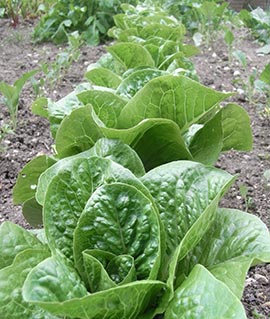
Continue to pull leeks as required. These will withstand harsh weather so there is no hurry to use them up. The main concern in the coming months is being able to get them out of the ground if it is frozen.
After having had a frost or two on them, they sweeten up and are ready for harvest. Like leeks, they can be left in the ground and pulled as required, providing the ground isn’t too hard to get them out.
